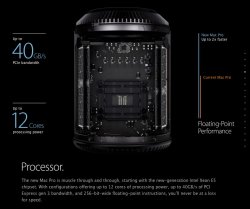The Apple page says "up to 12 cores" & intel XEON E5 chipset but the intel website shows only E5 processors up to 8 cores.
http://www.intel.com/content/www/us...n/compare-intel-processors.html?select=server
So is the Mac Pro dual processor & this prototype has one?
http://www.intel.com/content/www/us...n/compare-intel-processors.html?select=server
So is the Mac Pro dual processor & this prototype has one?



